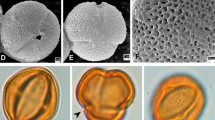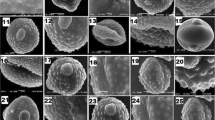Abstract
A comparative palynological study of 22 taxa (9 of which are endemic) of the genus Arabis L. (Brassicaceae), belonging to six sections, was conducted with acetolyzed and non-acetolyzed pollen grains using light microscopy (LM) and scanning electron microscopy (SEM). Descriptions of pollen, LM and SEM were provided. All pollen grain shapes of said species were separately calculated. Total pollen shape of Arabis is mostly oblate-spheroidal (43.09 %), but also contains prolate-spheroidal (23.27 %), subprolate (22.04 %), suboblate (6.54 %), prolate (4.04 %) and oblate (0.54 %). All pollen grains are tricolpate, but some of them are 2- and 4-colpate. In this study, there are described three pollen morphotypes of Arabis: Alpina type, Nova type, and Hirsuta type. The systematic potentialities oriented to the pollen data of the taxa studied at various systematic levels are also discussed.




Similar content being viewed by others
References
Al-Shehbaz IA (1988) The genera of Arabideae (Cruciferae; Brassicaceae) in the southern United State. J Arnold Arbor 69:85–166
Al-Shehbaz IA (2005) Nomenclatural notes on Eurasian Arabis (Brassicaceae). Novon 15(4):519–524
Anchev M, Deneva B (1997) Pollen morphology of seventeen species from family Brassicaceae (Cruciferae). Phytol Balcanica 3(2–3):75–82
Andrzejowski AL (1828) Arabis L. In: Mössler JC, Reichenbach HGL (eds) Hand Gewachsk Fl Deutsch, vol 2. pp 1150
Bıçakçı A, Güleryüz G (1998) Uludağ’ da yayılış gösteren Scrophulariaceae ve Brassicaceae familyalarına ait bazı endemiklerin pollen morfolojileri. Kasnak Meşesi ve Türkiye Florası Sempozyumu Bildiri ve Poster Kitapçığı, 719–726
Boissier E (1867) Flora orientalis. Genova et Basilease 1:165–178
Busch NA (1909) Arabis L. In: Kusnezow, Busch N, Fomin A (eds) Flora caucasica critica (Materialy dlia flory Kavkaza), vol 3. pp 471–500
Busch NA (1939) Arabis L. In: Busch NA (ed) Flora of U.S.S.R. VIII Moskva-Leningrad: Izdatel’stvo Akademii Nausk S.S.S.R. (Israel Program for Scientific Translations; Jerusalem, 1970), pp 130–148
Cain SA, Cain LG (1944) Size frequency studies of Pinus palustris pollen. Ecology 25:229–232
Cronquist A (1968) The evolution and classification of the flowering plants. Thomas Nelson Ltd, Edinburgh
Cullen J (1965) Arabis L. In: Davis PH (ed.) Flora of Turkey and the east Aegean Islands, vol 1. Edinburgh University Press, Edinburgh, pp 422–429
Davis KO (2001) An important tool for discovering historic ecosystems. In: Howell E, Egen D (eds) The historical ecology handbook. Island Press, Washington, pp 233–234
Davis PH, Mill RR, Tan K (eds) (1988) Arabis. Flora of Turkey and the east Aegean Islands, vol 10. Edinburgh University Press, Edinburgh, p 49
De Candolle AP (1821) Regni vegetabilis systema naturale. Paris 2:213–244
Erdtman G (1952) Pollen morphology and plant taxonomy Angiosperms. Altham Mass, Stockholm
Erdtman G (1960) The acetolysis method. A revised description. Sven Bot Tidskr 54:561–564
Faegri K, Iversen J (1989) Textbook of pollen analysis. Willey, Chichester, p 328
Halacy ED (1968) Conspectus Florae Greacae 1:51–55
ICBN International Code of Botanical Nomenclature (Vienna Code) (2006) Regnum Vegetabile 146. http://ibot.sav.sk/icbn/main.htm. Accessed March 2011
İnceoğlu Ö, Karamustafa F (1975) The pollen morphology of plants in Ankara region II. Cruciferae Comm de la Fac des Sci dé ľUniv ďAnkara 111–115
Kawecka B (1926) U ber die Veranderlichkeit des Pollens bei einigen Oenotheren. Bulletin of the International Academy of Polish Science, Series B, London, pp 329–360
Khalik KA, Maesen LJG, Kopman WJM, Berg RG (2002) Numerical taxonomic study of some tribes of Brassicaceae from Egypt. Plant Syst Evol 233:207–221
Koch M, Haubold B, Mitchel-Ods T (2001) Molecular Systematics of Brassicaceae: evidence from coding plastic matK and nuclear Chs sequences. Am J Bot 88(2):534–544
Kordofani M, Ingrouille M (1992) Geographical variation in the pollen of Acacia (Mimosaceae) in Sudan. Grana 31(2):113–118
Kuprianova A (1967) Apertures of pollen grains and the evolution in Angiosperms. Paleobot Palynol 3:73–80
Lahham JN, Al-Eisawi D (1987) Pollen morphology of Jordanian Cruciferae. Mitteilungen Der Botanischen Staatssammlung München 23:355–375
Mayer CA, Bunge AA (1831) Flora altaica. Berolini 15–27
Mössler JC, Reichenbach HGL (1828) Hand Gewachsk Fl Deutsch, vol 2. p 1150–1159
Mutlu B (2002) Revision of Arabis genus in Turkey. Unpublished D. Phil. thesis, Hacettepe University
Mutlu B (2004) A new species of Arabis L. (Brassicaceae) from inner anatolia. Bot J Linn Soc 145:251–256
Mutlu B, Erik S (2012a) Lectotypification, description, and distribution of Arabis deflexa Boiss. (Cruciferae). Turk J Bot 36:21–22
Mutlu B, Erik S (2012b) The taxonomical position of Arabis graellsiiformis Hedge (Brassicaceae) that it’s known as an endemic species of Turkey. Hacettepe J Biol Chem 40(1):69–74
Parolly G, Hein P (2000) Arabis lycia (Cruciferae), a new chasmophyte from Taurus Mts Turkey, and notes on related species. Willdenowia 30:293–304
Porch TG, Jahn M (2001) Effects of high-temperature stress on microsporogenesis in heat-sensitive and heat-tolerant genotypes of Phaseolus vulgaris. Plant Cell Environ 24:723–731
Punt W, Blackmore S, Nilsson S, Le Thomas A (1994) Glossary of pollen and spore terminology. Lab Palaeobot Palynol, Utrect, p 71
Rholf FJ (2000) NTSYS-PC numerical taxonomy and multivariate analysis system version 2.1. Applied Biostatistic Inc, New York
Rollins RC, Banerjee MAUC (1979) Pollen of Cruciferae, Busey Institution of Harvard University, Cambridge
Savulesku T (1955) Flora Republich Populare Romine. Editura Academiei Republich Populare Romine 3:292–307
Sokal R, Rohlf FJ (1981) Biometry. Freeman, New York
SPSS Inc. (2006) SPSS® Base 15.0 for windows, Chicago
Takhtajan AL (1980) Outline of the classification of flowering plants (Magnoliophyta). Bot Rev 46(3):246–248
Talavera S (1996) Arabis L. In: Castroviejo S, Aedo C, Gomez CC, Lainz M, Montserrat P, Morales R, Munoz GF, Nieto FG, Rico E, Talavera S, Villar L (eds.) Flora Iberica, Real Jardin Botanico, vol 4. Csic, Madrid, pp 135–163
Talavera S, Veleyos M (1992) Sinopsis del Genero Arabis L. (Brassicaceae) en la Peninsula Iberica e Islas Balearesi. Annales Jardin Botanico de, vol 50. Madrid, pp 146–150
Vezey EL, Shah VP, Skvarla JJ, Raven PH (1988) Morphology and phenetics of Rhizophoraceae pollen. Ann Missouri Bot Gard 75:1369–1386
Walker JW (1974) Evolution of exine structure in the pollen of primitive angiosperms. Am J Bot 61:891–902
Wodehouse RP (1935) Pollen grains. McGraw-Hill, New York
Yang M, Zhang D, Zheng J, Lui J (2000) Pollen morphology and its systematic and ecological significance in Rheum (Polygonaceae) from Chine. Nordic J Bot 21(4):411–418
Yeloff D, Blokker P, Boelen P, Rozema J (2008) Is pollen morphology of salix polaris affected by enhanced UV-B irradiation? Results from a field experiment in high arctic tundra, arctic, antarctic, and alpine research. 40(4): 770–774
Yıldız K, Gücel S, Dadandı MY (2009) A palynological investigation of endemic taxa from northern Cyprus. Pak J Bot 41(3):991–1007
Acknowledgments
This study was a part of the requirements for the Ph degree submitted to Hacettepe University on December 2002 and sported by the Scientific Research Unit of Hacettepe University (Project no 97.02.601.001). The authors are thankful to Dr. Cahit Doğan, Dr. Burcu Bursalı and Dr. İlginç Kızılpınar for helpful prepared of some pollen samples. We are also thankful for the technical help provided by the staff of the Laboratory of Electron Microscopy at the Kırıkkale University (Dr. Kutalmış Güven and Dr. Hakan Güngüneş) and Inonu University (Dr. Murat Özabacı).
Author information
Authors and Affiliations
Corresponding author
Electronic supplementary material
Below is the link to the electronic supplementary material.
Rights and permissions
About this article
Cite this article
Mutlu, B., Erik, S. Pollen morphology and its taxonomic significance of the genus Arabis (Brassicaceae) in Turkey. Plant Syst Evol 298, 1931–1946 (2012). https://doi.org/10.1007/s00606-012-0692-7
Received:
Accepted:
Published:
Issue Date:
DOI: https://doi.org/10.1007/s00606-012-0692-7




